Transforming Bedroom Spaces Through Thoughtful Painting
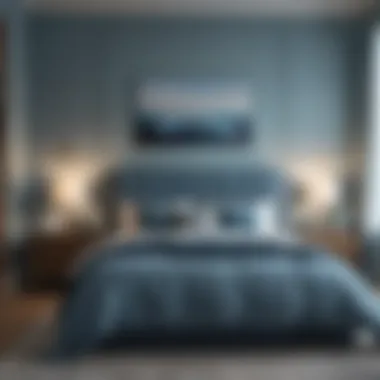

Intro
A bedroom is more than just four walls and a bed; it's a personal sanctuary, a haven where one can unwind and recharge. The significance of painting in these spaces often goes beyond merely choosing a hue. It's about mood, atmosphere, and the emotional response that color elicits. The interplay of light, space, and color can work wonders to elevate a bedroom from mundane to magnificent.
In this discussion, we'll take a stroll through the canvas of your bedroom, uncovering how painting can serve as a transformative tool in creating environments that align with individual preferences and wellbeing. Expect to dive into creativity, armed with insights on methodologies, the psychology behind color selection, and practical suggestions on crafting a space reflective of your personality.
Design Inspirations
When it comes to giving your bedroom a fresh look, design inspirations serve as the guiding light. They can spark ideas that steer the entire process, making color selection and technique choices much clearer.
Trending Styles
Today, there's a strong inclination towards styles that are both functional and aesthetic. Minimalism is one such trend where simplicity reigns—think clean lines and a limited color palette. Soft whites, greys, and the occasional pastel make room for openness and lightness. Alternatively, the bohemian style embraces a more relaxed vibe with layered textures and bold colors that reflect a free-spirited attitude.
Mid-century modern continues to capture hearts too, blending vintage charm with modern sensibilities. This style often leans on earthy tones combined with striking accent colors. However, trends evolve. So, tapping into individual preferences ensures that what's on-trend also feels personal.
Color Palettes
Choosing the right color palette can be a daunting task. A successful palette must resonate with the occupant's mood and purpose of the space. Here are a few suggestions:
- Cool Tones: Shades of blue or green are known for their calming effects. With their ability to mimic nature, cool colors create a subtle sense of serenity, ideal for a refreshing atmosphere.
- Warm Tones: Rich reds, oranges, and yellows can ignite a feeling of warmth and comfort. They are fantastic for adding vibrancy and energy, particularly in an otherwise cozy setting.
- Neutral Tones: These provide a sturdy foundation, allowing for playful accents. Colors like beige, ivory, and taupe can work wonders when blending with other hues and textures in the room.
All in all, while selecting colors and themes, consider how they'll interplay with existing decor—textures, furniture styles, and personal items can greatly influence the effectiveness of your chosen hues.
"The right color can create not just a pleasing visual atmosphere, but also signal the kind of space you want to inhabit—be it restful, energizing, or somewhere in between."
Next, we can delve into practical aspects to maintain the beauty and functionality of your painted sanctuary, ensuring it remains a place of solace and creativity.
Maintenance and Upkeep
Once your chosen hues are settled and the brush has done its magic, keeping the vibrancy alive becomes the next priority. Proper maintenance helps the painted surfaces maintain their luster and keeps your bedroom looking its best.
The Role of Color in Sleep Environments
Color isn’t merely an aesthetic choice; it plays a significant role in shaping the ambiance of bedrooms. The hues on your walls can subtly affect your mood, influence your sleep quality, and contribute to the overall energy of the space. With so many shades to choose from, recognizing how various colors interact with our emotions and subconscious is vital for crafting an ideal sleeping environment.
Psychological Effects of Color
Different colors evoke distinct feelings. For instance, calming colors like soft blues and greens often promote relaxation, encouraging individuals to unwind after a long day. In contrast, vibrant yellows may stimulate energy and creativity, making them less suitable for a peaceful sleep atmosphere.
The psychological impact of colors can be likened to music; a soothing melody can easily lull one to sleep, whereas an upbeat tune might keep you on your toes. This analogy exemplifies how color acts harmoniously in our spaces. The idea is to choose shades that resonate positively with your personal experience and lifestyle.
For instance:
- Earthy Tones: Rich browns and muted greens can evoke a sense of security and connection to nature, creating a serene retreat.
- Pastel Shades: Light pinks or soft lavenders are often associated with tranquility and comfort, fostering a nurturing atmosphere.
- Cool Colors: Colors like teal or navy blue can reduce stress, not to mention they have a quietly sophisticated appeal.
Understanding these effects can lead to better sleep hygiene, as a carefully curated color palette makes your bedroom a sanctuary, reminiscent of nature or a calm oasis, instead of a bustling café or vibrant marketplace.
Color Schemes for Restfulness
Creating a color scheme that promotes rest involves pairing shades that complement one another while evoking a tranquil vibe. Here are a few approaches you might consider:
- Monochromatic: Sticking to various shades of a single color can create a cohesive, seamless look that feels calm and orderly. Think of layering different hues of blue in various textiles and wall treatments.
- Analogous Colors: Selecting colors that sit next to each other on the color wheel—like blue, blue-green, and green—will give a gentle, soothing effect without jarring contrasts. This technique can illuminate your space beautifully while remaining softly engaging.
- Neutral Bases with Accents: A neutral backdrop tends to recede, giving prominence to accent colors. Soft beige or muted gray walls with rich accent pillows in autumnal hues offer a perfect balance, allowing for personal expression while maintaining tranquility.
By keeping the overall tone soft and grounded, you encourage restful feelings, steering clear of high-impact colors that might provoke mental overstimulation.
Choosing Colors Based on Personal Preference
Everyone has unique relationships with colors, often rooted in personal experiences or cultural backgrounds. Choosing colors should, therefore, reflect not just psychological principles, but also your preferences. What feels good to you?
- Cultural Influences: Some cultures favor vibrant colors while others prioritize minimalism and muted palettes. Embracing a color that's significant to your background can foster a sense of belonging and peace in your personal space.
- Personal Experiences: Reflect on colors that bring back special memories or convey emotions you want to foster. A warm golden beige may evoke cozy family gatherings, while a serene blue might remind you of calming days by the sea.
- Experimentation: Don't hesitate to test samples on your walls. Shadows and light affect how colors look at different times of the day. Sometimes, a color that feels perfect in one space might be too overwhelming in another.
"Color is the keyboard, the eyes are the harmonies, the soul is the piano with many strings." - Wassily Kandinsky
Embrace this art; your bedroom deserves it.
Painting Techniques for Unique Effects
When it comes to revamping a bedroom, the choice of painting techniques can make all the difference. Beyond simply adding color, unique effects can transform walls into expressive art pieces. Not only do these techniques enhance visual appeal, but they can also play a big role in setting the mood and atmosphere of the space. From texture to layering hues, exploring various methods can help you achieve a profile that speaks to your personal style and preferences.
A significant feature of these techniques is their ability to elevate the standard paint job into something imaginative and refreshing. Effects like sponging or stenciling can break away from monotony, while also maintaining an understated elegance. If you're eager to learn how to make your bedroom stand out, discovering these innovative approaches is essential.
The Importance of Primer
Primer is an often-neglected step in painting, yet it plays a pivotal role in painting techniques. Using a quality primer creates a smooth canvas for the paint, ensuring that colors appear vibrant and true to form. It simultaneously promotes better adhesion and helps combat issues like peeling or fading over time.
Moreover, when engaging in textured painting methods, primer can offer a better footing for layered applications. There’s nothing worse than putting time and effort into a paint job only for it to crack or deteriorate rapidly. By investing in a solid primer beforehand, you pave the way for a job that reflects your envisioned bedroom sanctuary.
Textured Painting Methods
Textured painting methods add dimension and character to your bedroom walls. Here are some popular techniques:
Sponging
Sponging is one of those techniques that can confer a natural and softly weathered look to walls. The key characteristic of sponging is its ability to blend hues while producing an organic texture reminiscent of nature. It's a beneficial choice for homeowners looking to introduce layers without overwhelming a room.
The unique feature of sponging lies in its versatility. You can use contrasting or similar colors to create depth, making it suitable for various design aesthetics. Furthermore, it works particularly well in cozy spaces but can be a bit more challenging to execute effectively without the right tools. Practice and patience are essential here, but the reward is worth it.


Rag Rolling
Rag rolling is another fantastic technique where a rag is rolled onto the freshly painted wall. Unlike sponging, this method produces a dynamic and playful appearance, characterized by streaks and patterns that seem to dance across the surface. Rag rolling is popular due to the possibility of combining multiple colors and achieving a soft visual impact.
One of the advantages of rag rolling is that it works splendidly with various color palettes, allowing for creative exploration. However, it can require a certain level of finesse to get consistently appealing results, meaning newcomers might face a learning curve.
Stenciling
Stenciling brings in a whole world of design possibilities. This technique involves applying a cut-out design—either bought or homemade—onto the wall, allowing for precise, repeatable patterns. Stenciling's key characteristic is its ability to add intricate patterns without needing a wallpaper or decals, making it a beneficial choice for those who want a tailored look.
What makes stenciling unique is the extent of creativity it allows. From floral motifs to geometric shapes, stencils can turn a plain wall into a focal point in an effortless manner. One might face challenges like paint bleeding under the stencil, but using high-quality materials can generally mitigate this issue.
Ombre and Gradient Techniques
Ombre and gradient techniques can lead to stunning visual effects by transitioning smoothly from one color to another or from light to dark. This method is often favored for its contemporary edge and ability to create an illusion of height or breadth in a room, making it particularly useful in spaces with high ceilings or compact dimensions. The gentle blending of colors can create a harmonious atmosphere, which is perfect for a bedroom geared toward relaxation.
Combining Paint with Other Elements
Wall Stickers
Wall stickers offer a quick and easy way to personalize a space without extensive commitment. They come in various designs that can complement the existing color scheme without requiring another paint job. The key characteristic of wall stickers is their convenience; they can be applied and removed without damaging the paint beneath.
Their unique feature is the ability to update your decor anytime you want without much hassle. However, the concern with wall stickers is their longevity; depending on the quality, they can peel over time, calling for replacement.
Artwork Integration
Integrating artwork with your paint scheme can create a striking combination that elevates your bedroom aesthetic. This technique encourages a cohesive theme that resonates through wall art colors and styles that match or contrast with the wall paint.
The beauty of artwork integration lies in its personalization potential. Personal photographs, prints, and frames can add character that tells a story. Be cautious, though, as clashing colors may dilute the overall effect, and choosing complementary pieces is a finer point to consider in achieving a beautifully curated look.
Effective painting techniques, combined with personal elements, allow you to turn your bedroom into a unique escape, merging functionality with exquisite flair.
Setting the Mood with Color Combinations
Color combinations in a bedroom can either soothe the spirit or excite the senses—often both, depending on how they're applied. This particular section dives into how thoughtful color palettes can shape the feeling and functionality of one's personal sanctuary, proving that there's more to bedroom painting than merely slapping on a coat of paint. Different hues and their combinations can influence moods, boost creativity, and even impact sleep. Hence, understanding the nuances behind color schemes is paramount for anyone looking to create a space that feels uniquely theirs.
Complementary Colors and Their Impact
Complementary colors sit opposite each other on the color wheel, providing a striking visual contrast that can invigorate a room. Think of bold oranges contrasted with deep blues or vibrant reds alongside muted greens. When devising a bedroom aesthetic, incorporating these goes beyond mere aesthetics; it sparks energy and can even elevate one’s mood.
For instance, a subtle application of complementary colors can highlight architectural features or create focal points in the room. It’s a bit like adding spice to a dish; too much can overpower, but the right balance makes things deliciously inviting. One might consider using complementary colors for accessories like pillows, artwork, or even accent walls, presenting an elegant contrast without overwhelming the entire space.
"Choosing the right complementary color can transform a tired room into a vibrant space."
Dynamic Monochrome Schemes
Monochrome schemes, where various shades of a single color are utilized, can create a clean, serene atmosphere, ideal for relaxation. Utilizing an array of blues, for instance, can mimic soothing water elements, while shades of gray may instill a sense of calmness. This technique allows for a broad depth of tone, adding visual interest without competing hues distracting the eye.
While monotone might sound dull, it can be anything but. Adding textures through fabrics, furniture, and decorative accents can lift the whole look to new heights. You may consider layering in fabrics with different textures, or varying the brightness of lights to see how the same shade transforms under different conditions.
Nature-Inspired Palettes
Mother Nature offers some of the most beautifully coherent color combinations one could find. Forest greens, sky blues, and earthy browns can make anyone feel truly connected to the great outdoors, an especially significant boon for city dwellers. Bringing this kind of palette into a bedroom can promote relaxation and enhance feelings of well-being.
For a refreshing touch, consider using colors found in botanical gardens or natural landscapes. Light soft greens combined with creamy whites can replicate a garden's serene ambiance. For those craving a little more punch, integrating deep, rich colors reminiscent of autumn leaves can add warmth to the space.
When understanding these aspects of color combinations, it's vital to consider personal preferences and lifestyle. A thoughtfully executed color scheme can evoke a profound impact that resonates throughout the room, ultimately shaping the experiences lived within it.
Practical Steps to Painting Your Bedroom
When it comes to redefining your bedroom through a fresh coat of paint, it’s not just about splashing color on the walls and calling it a day. Practical steps are crucial in orchestrating a successful transformation. These foundational actions set the stage for achieving the desired look and feel while ensuring that the process unfolds smoothly. To truly make a mark, homeowners must understand the significance of planning, execution, and maintenance in the realm of bedroom painting.
Planning and Preparation
Measuring Spaces
Getting your measurements right is the first step toward a flawless painting experience. Precision in Measuring Spaces contributes significantly to the overall outcome of your project. Knowing the dimensions of your room helps in calculating how much paint you’ll need, which can save you both time and money — two invaluable resources. Measure the length, height, and width of your walls, taking note of any architectural features like windows and doors.
One of the key characteristics of measuring is its ability to prevent over or under-buying paint. An effective plan hinges on these measurements, reducing the risk of running short mid-project or having excess paint left behind. A unique feature of using precise measurements is its role in visualizing color placement; when you know the sizes and dimensions, you can better envision how different shades will interact within your space.
While beneficial, measuring also comes with its slight challenges — it can be easy to mismeasure or overlook particular areas, which may lead to incorrect calculations. Taking your time here is essential.
Gathering Supplies
Gathering your supplies is the next crucial step in the painting process. In the context of Gathering Supplies, a well-curated toolkit ensures you are prepared for what's ahead. The essentials typically include paint, paintbrushes, rollers, drop cloths, painter's tape, and a primer if needed.
The key characteristic of amassing these tools is that they empower you to get the job done efficiently and effectively. Each item plays its part: for instance, painter's tape helps achieve clean edges and lines, while drop cloths protect your flooring from drips and spills.
A unique aspect of gathering supplies lies in selecting the right paint finish. Different finishes — matte, satin, or gloss — not only influence the aesthetic but also the longevity of your paint job. This decision should be guided by both functionality and personal preference; while a glossy finish might pop in a bright room, it can also highlight imperfections.
That said, it’s crucial to be mindful of your budget. Quality supplies might cost a bit more upfront, but their impact on the final result is undeniable. Getting cheap supplies might seem attractive, but it can lead to subpar outcomes, which might require you to repaint sooner rather than later.
Executing a Flawless Paint Job
Once you have everything in place, the excitement builds up to executing the paint job itself. Here, meticulous attention to detail can make a world of difference. Start by preparing the room: remove furniture, and cover anything that can’t be moved. Apply painter’s tape to edges and corners, so you maintain clean lines, then give your walls a good wash if necessary.
Now you’re set to apply the primer. Though it may seem optional, primer fills in small cracks, creates an even base, and enhances the paint’s durability. Apply your base coat using smooth, even strokes, and allow ample drying time between layers. A common pitfall is rushing this step — patience usually pays off.
Post-Painting Care and Maintenance
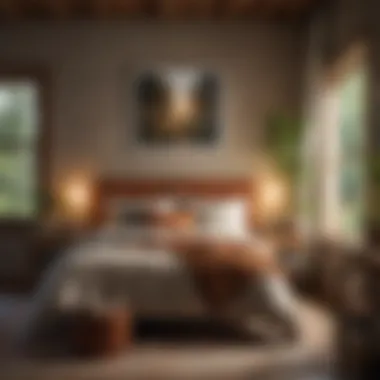
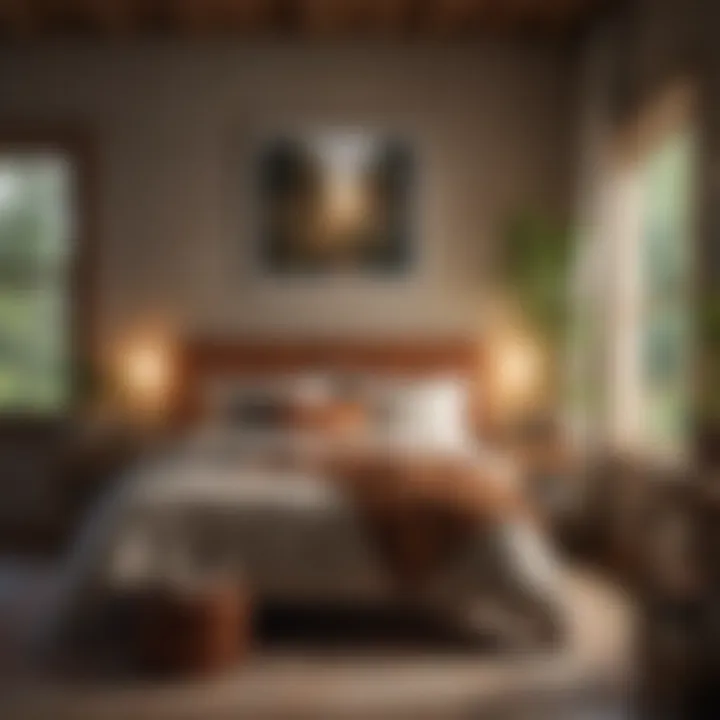
After all the hard work you've put into painting, it’s just as crucial to consider Post-Painting Care and Maintenance. Once the paint has dried, it's important to remove the painter's tape slowly to ensure no paint peels away with it. You might also want to inspect your walls for any spots that need touching up — these little details can dramatically enhance the finish.
Finally, maintaining the paint job can extend its life. Regularly dusting the walls and occasionally wiping them down with a damp cloth helps prevent dirt and grime buildup. If your walls are painted in a finish that’s washable, don’t hesitate to scrub off minor marks. Keeping your paint job in top shape not only preserves the effort you put into it but also maintains the room’s overall aesthetic appeal.
Incorporating Architectural Elements and Molding
In the realm of bedroom aesthetics, the impact of architectural elements and molding cannot be overstated. These features serve as more than mere decorative accents; they play a vital role in how a space is perceived and experienced. By integrating molding effectively, one can elevate the overall design while providing a sense of character and depth to the room. This article focuses on how to choose and implement these elements, harnessing their potential to transform an ordinary bedroom into a visually stunning sanctuary.
Choosing the Right Molding Style
The selection of molding is crucial because various styles can evoke different moods and themes in a bedroom. For instance, ornate crown molding may enhance a traditional setting, creating an air of elegance and sophistication. Conversely, sleek and minimalistic baseboards can blend seamlessly into a modern, minimalist design. Additionally, consider the proportions of your room. In a larger space, taller moldings can draw the eyes up, while in a cozier bedroom, shorter options might make the walls feel less overwhelming.
- Traditional: Elegant curves and intricate designs
- Modern: Clean lines and simple shapes
- Rustic: Rough-hewn textures and natural finishes
When in doubt, research styles that resonate with your personal taste. A quick exploration of platforms like Pinterest or Instagram can provide abundant inspiration.
Painting Techniques for Molding
Painting molding can be tricky, but implementing the right techniques can yield professional results. First off, priming is essential; it ensures that paint adheres better and covers any previous colors or textures. Use a high-quality brush for detailed areas, while a small foam roller may be ideal for larger flat sections. Here are some key techniques:
- Edge Painting: Carefully paint the edges where the molding meets the wall. Use painter's tape to avoid smudges.
- Two-Coat Approach: Apply a thin first coat, let it dry completely, then follow up with a second for full coverage.
- Finish Selection: A satin or semi-gloss finish often works best for molding as it adds a subtle sheen and is easier to clean.
Harmonizing Molding with Wall Colors
The interaction between wall colors and molding is pivotal for creating a well-balanced look. Consider the following:
- Contrast Effect: Dark-colored moldings against lighter walls create a striking contrast that can define a space's elegance. For instance, a deep navy molding can add drama to soft beige walls.
- Color Coordination: Alternatively, painting both the walls and molding in similar hues can create a cohesive and seamless appearance, perfect for enhancing a sense of space without overwhelming it.
- Accent Colors: Use a bolder color for the molding as an accent that draws attention to architectural features. For example, a mint green wall paired with bright white molding can bring freshness to the space without overpowering it.
"The way in which colors and elements interact can truly breathe life into a bedroom, making it a haven of comfort and style."
Sustainable and Eco-Friendly Painting Options
In recent years, the discussion about sustainable and eco-friendly ways to carry out home improvements has gained significant momentum. When it comes to painting bedrooms, making thoughtful choices offers a dual benefit: not only does it foster a healthier living environment for residents, but it can also ease the burden on our planet. As we consider the art of painting, it becomes imperative to explore options that minimize harmful impacts on health and the environment. This section dives into everything from eco-friendly paint options to responsible disposal methods, emphasizing that transforming bedroom spaces doesn’t have to come at the expense of wellbeing or sustainability.
Understanding Eco-Friendly Paints
When we talk about eco-friendly paints, it’s essential to understand what makes them different from the conventional varieties. Typically, traditional paints can contain a cocktail of harmful chemicals, emitting volatile organic compounds (VOCs) that can linger in the air long after the painting job is complete. In contrast, eco-friendly paints are formulated without most of these harmful substances, featuring natural components derived from minerals, plants, or water-based formulas. Choosing such products can significantly reduce indoor air pollution, creating a breathable environment ideal for sleep and relaxation.
Some notable eco-friendly options that paint lovers should consider include:
- Natural Paints: Made from natural ingredients like clay, chalk, or plant oils. These have little to no VOCs.
- Lime Wash: An ancient recipe that not only provides a beautiful finish but also helps in regulating humidity.
- Milk Paint: A biodegradable option created from natural proteins, best for those looking for an old-world aesthetic.
By opting for these paints, homeowners can reconnect with nature while uplifting their interior aesthetics.
Low-VOC and Zero-VOC Options
The term "low-VOC" refers to paints that contain a significantly lower concentration of volatile organic compounds compared to their traditional counterparts. These low-VOC paints release fewer pollutants into the atmosphere, greatly benefiting both your health and that of the planet. Similarly, zero-VOC paints take this a step further, ensuring that no VOCs are present at all. However, it's critical to note that while these paints are healthier, their performance can depend on various factors, including the specific brand and the type of finish.
When shopping for paints, look for certifications like the Green Seal or Environmental Choice program label, which can be a trustworthy indicator of eco-conscious manufacturing. It’s also worth considering the texture and finish of your selected paint, as some might have a more matte effect while others shine, impacting how light interacts with the walls.
Recycling and Disposal Practices
Once the painting project wraps up, homeowners face an often-overlooked part of eco-friendly painting: disposal. Many might toss leftover paint cans into the household trash, but that’s a mistake that can harm the environment. Instead, proper recycling and disposal of paint is crucial.
Here are some recommendations on how to go about it:
- Check Local Regulations: Many communities have specific regulations for hazardous waste, which include paint.
- Participate in Paint Recycling Events: Local governments sometimes organize events to collect leftover paint for recycling.
- Donate Unused Paint: If you have good quality paint left, consider donating it to community centers or schools.
A little due diligence in the disposal methods can prevent harmful chemicals from leaching into the ground and causing environmental damage. Taking these steps not only supports sustainability efforts but also reinforces the idea that every touchpoint in home improvement counts.
"Environmental responsibility starts in our own homes - every brush stroke can contribute to a greener planet.”
Cultural Interpretations of Bedroom Paintings
Understanding the cultural interpretations of bedroom paintings reveals layers of meaning behind color choices and design trends. Cultures around the world express their identity and values through their living spaces, and the bedroom is no exception. The nuances of color and decoration not only set the mood but also reflect historical narratives and social dynamics within a particular community. By examining these interpretations, homeowners and designers can draw inspiration that resonates on a deeper level with their personal connections, elevating the act of painting beyond a mere aesthetic pursuit into an art form enriched with cultural significance.
Historical Perspectives on Bedroom Colors
Historically, the colors chosen for bedrooms were often linked to the prevailing cultural norms and available materials. For instance, in ancient Egypt, bright, warm hues symbolized vitality and the afterlife, hence was common in the design of tombs, explicitly influencing design elements in their homes. Fast forward to the Victorian era, where darker shades represented mourning and somberness, reflecting societal attitudes towards death and loss. Today, many modern interpretations draw on these historical influences but adapt them to convey personal stories and emotions rather than broader cultural narratives.
In cultures with colonial histories, the remnants of imperialist influence on color preferences are stark. Lighter colors often translated to luxury and sophistication, while traditional, darker palettes might hold deeper cultural ties. Considering these perspectives when selecting bedroom paint can guide you toward choices that acknowledge and respect historical contexts while establishing personal comfort and style.
Regional Color Preferences
Vibrant palettes often characterize the cultural landscape, but they vary widely from region to region. For example, in coastal areas like the Mediterranean, soft blues and whites mimic the sea and sky, providing a calming backdrop that invites relaxation. In contrast, the rich, earthy tones prominent in many Southwest American homes draw inspiration from the surrounding desert landscape, celebrating a connection to nature.
When exploring these regional preferences, take note of how colors are employed to respond to climate and environment. Warmer climates often utilize cooler colors to create a refreshing atmosphere while avoiding dark shades that absorb heat. Conversely, in Nordic countries, muted hues are common due to the long winters, creating an inviting space even in minimal light.
Ultimately, recognizing these regional tendencies can inform your decision-making process, ensuring that your bedroom not only reflects personal taste but also aligns with broader regional narratives.
Symbolism in Color Choices
Colors are imbued with symbolic meanings that transcend mere aesthetics. In many Eastern cultures, red embodies luck and prosperity, making it a favored choice for bedrooms, particularly for newlyweds. In contrast, many Western cultures associate blue with tranquility and stability, often making it the go-to choice for creating serene sleeping spaces.
Beyond cultural norms, personal experiences and backgrounds shape what colors symbolize for each individual. For instance, someone may hold fond childhood memories associated with a sunny yellow room, driving their preference for bright, cheerful colors in their own space.
By considering both the general and individual meanings of colors, one can curate a bedroom painting scheme that is not only visually appealing but also rich with significance, creating a harmonious environment conducive to rest and reflection.
"Color is a power which directly influences the soul." — Wassily Kandinsky
Integrating these layers of meaning can transform the bedroom from a simple sleep space to a personal sanctuary that resonates with one’s identity and values. Emphasizing both historical and cultural contexts enables a deeper appreciation of how painting practices can be both a creative outlet and a reflection of who we are.
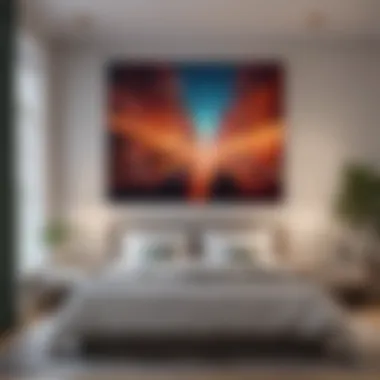
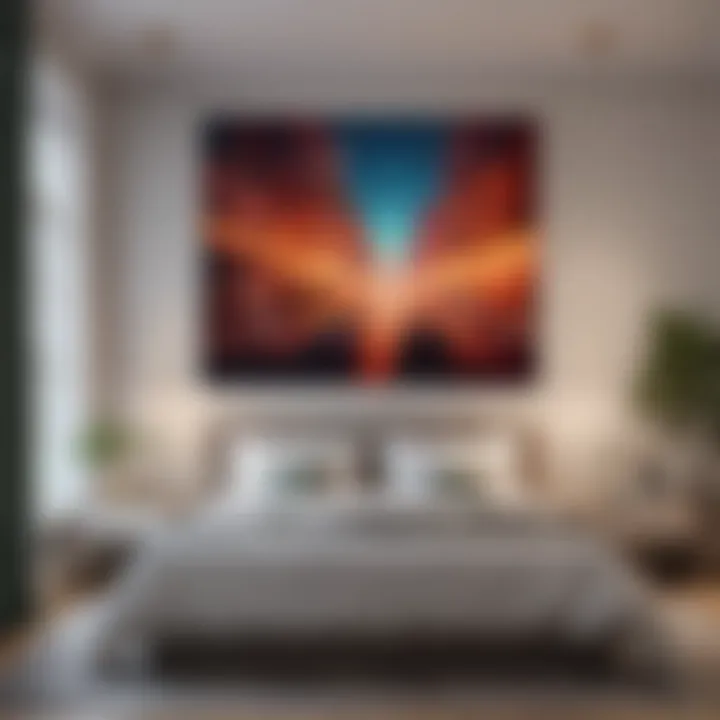
The Influence of Trends on Bedroom Decoration
Trends in bedroom decoration can be likened to the ever-fluctuating tides of the ocean—sometimes calm, other times wild. They inform choices of color, style, and even functionality, shaping our living spaces in profound yet subtle ways. Understanding these trends isn't just about aesthetics; it’s about creating environments that resonate with our personal experiences and emotional well-being. By tapping into current trends, homeowners can elevate their bedrooms from mere sleeping quarters into cohesive sanctuaries that reflect their character and preferences.
More than just fleeting fashions, trends often stem from deeper cultural, societal or technological shifts. For instance, the rise of open-concept living has fostered a demand for bedrooms that don’t just serve a singular purpose but reflect an integrative approach to home design. Trends also encourage innovation; they push boundaries, challenge norms, and invite homeowners to experiment with color, texture, and spatial relationships.
"To embrace trends is to invite impetus into our homes; without them, interiors can feel static and uninviting."
Examining Current Trends
Engaging with current trends exposes one to various palettes, styles, and ideas that stir creativity. Popular trends often emerge from various influences such as fashion, pop culture, and even the way individuals live their lives. For instance, the popularity of biophilic design—which reconnects inhabitants with nature—has brought earthy tones and organic materials back into fashion. Similarly, minimalist design, characterized by simplicity and functionality, remains steadfast as people seek to declutter both physically and mentally.
- Muted Pastels: Soft, muted colors have become a hit, reflecting a desire for calm and serenity. Think gentle pinks, soft blues, and earthy greens that don’t shout but rather whisper tranquility.
- Vintage and Retro Elements: There’s a resurgence of nostalgia with vintage items making a strong comeback. Think of retro patterns or antique furniture that infuse warmth and personality into a space.
- Smart Technology: Technology now plays a pivotal role in bedroom trends, with smart lighting and integrated systems allowing for personalized environments that can be easily adjusted.
Timeless vs. Trendy Approaches
When diving into interior design, one faces an ongoing dilemma: lean towards timeless elegance or the allure of trendy novelties. Timeless design conveys a sense of classic charm and longevity, often featuring neutral palettes, traditional furniture lines, and artwork that withstands the test of time. On the contrary, trendy approaches lean into contemporary styles, vibrant colors, and exciting patterns that may feel captivating today but may fade in popularity tomorrow.
Consider a balanced approach where elements of both are intertwined. For example:
- Foundation with Timelessness: Establish a neutral base with classic colors and evergreen furniture. This creates a sturdy foundation.
- Accent with Trends: Infuse trendy accessories such as throw pillows, artwork, or area rugs that can be easily updated without reshaping the entire room.
Integrating Personal Style with Trends
While trends can provide great inspiration, it’s critical to harmonize them with your unique style. Every person has those particular shades, textures, or themes that evoke a feeling or a memory. For instance, you could adore the calming effects of soft blues but also be drawn to the transient appeal of bold ochre. The art lies in blending these preferences into a cohesive vision.
- Reflect Through Color: Choose paint colors that resonate with your experiences. If the sea brings you comfort, shades reminiscent of water can be your go-to.
- Curate Meaningful Decor: Instead of filling your bedroom with trend-based items, select decor that holds significance—photographs, art pieces, or even books that speak to you.
- Stay Adaptable: Trends can offer excitement but also may require consistent updating. Allow room in your design plans to adapt as new inspirations arise, without compromising your core style.
In summary, while trends in bedroom decoration play a vital part in creating appealing spaces, the true essence of a bedroom lies in its ability to reflect one’s individuality, comfort, and sense of peace. By examining current trends, weighing timeless versus trendy approaches, and carefully integrating personal style, homeowners can achieve a space that is not only attractive but also deeply personal.
Creating a Cohesive Bedroom Aesthetic
Creating a cohesive aesthetic in your bedroom is not just about placing a few decorative items here and there. It's an art that requires careful consideration of various elements, harmonizing colors, materials, and styles that come together in an environment meant for relaxation and comfort. The benefits are manifold—beyond just eye-catching visuals, a well-coordinated space can promote mental calmness and enhance the overall atmosphere of the room.
When aiming for cohesiveness, several things should be at the forefront of your design efforts. Think about how every aspect within that space tells a story. The right balance can turn a room that merely exists into a sanctuary that resonates with your persona. Be it the color of the walls or the decor on the nightstand, everything should be in sync with your chosen theme.
"A well-coordinated room creates a story, pulling from every hue and texture to enhance the mood and feel."
Establishing a Theme
Establishing a theme is the first step in crafting a cohesive bedroom aesthetic. This theme acts as a roadmap for all future design decisions, guiding you on what colors to use, which furniture pieces to select, and even how to place them. Whether you lean toward a minimalist vibe, bohemian flair, or perhaps a rustic farmhouse feel, defining your theme clarifies since each element can either add to or detract from your core vision.
To find your ideal theme:
- Consider your personal style. What decorations or colors excite you?
- Look at trends for inspiration, but avoid simply copying them; these should resonate with you.
- Think about functionality. Sometimes practicality can be the leading force behind aesthetic choices.
Establishing a theme allows for exciting projects, like painting or creating wall art that fits seamlessly into the overall design. As you engage in this process, make sure to keep your unique personality as the focal point.
Matching Furniture and Decor with Wall Colors
Matching furniture and decor with wall colors is akin to weaving a fabric; each thread enhances and highlights the others. The key is to maintain a sense of balance. A color that works beautifully on the walls might clash horrifically with the furniture you choose. Hence, it’s crucial to select shades thoughtfully. For instance, earthy tones on the walls often play well with natural wood furniture, whereas brighter colors might complement modern, sleek metal accents.
Here are some strategies:
- Use color swatches to test how different furniture looks against your wall colors.
- Think of contrast; a light wall can pop with dark furniture, bringing visual interest.
- Seek harmony; shades in the same family but varying in intensity can lead to a sophisticated look.
Remember, it’s not just about colors; the materials of the furniture also play a crucial role. Heavy, dark woods can ground a room, while lighter or glass furnishings can add airiness and depth.
Layering Textures for Depth
Layering textures adds a tangible richness and comfort to a bedroom, providing an inviting atmosphere. It makes a visual impact that can engage all the senses, creating an experience rather than just a room. Textures can be woven through various materials—like soft linens on the bed, a plush throw, or rustic wooden frames.
To effectively layer textures:
- Combine fabrics. Think of mixing cotton, wool, and linen for bedding.
- Incorporate natural elements. Items like wooden or rattan furniture, paired with metal accents, create contrast.
- Use area rugs. They can delineate spaces and add warmth, especially in large rooms.
By blending these elements thoughtfully, you can create a space that feels complete and rich, engaging anyone who steps inside.
Cohesive bedrooms are not just for aesthetics; they enhance your sense of belonging and peace in a space often reserved for rest. As you embark on this transformation, remember that the journey itself is part of the beauty, nurturing creativity and personalization.
Maximizing Light and Space through Paint
In the realm of bedroom aesthetics, the interplay of light and space is paramount. The right paint choices and techniques can significantly enhance or diminish the perceived dimensions of a room. This section delves into how to effectively use paint to create a sense of openness and brightness, transforming even the coziest corners into inviting sanctuaries.
Choosing Light-Reflective Paints
Light-reflective paints serve as a simple yet powerful tool to amplify natural light. Selecting hues like soft whites or gentle pastels can make a bedroom feel more airy while enhancing sunlight during the day. These paints act like mirrors, bouncing light around and giving the illusion of a larger space. Consider satin or eggshell finishes; they provide enough sheen to reflect light without being overly shiny.
When pondering your options, it's important to also consider the room's orientation. A bedroom facing south may thrive with cooler shades, whereas a north-facing room often benefits from warmer tones to counteract any chilliness. By choosing the right reflective paint, you change how light fills the room, creating a welcoming atmosphere.
Techniques for Small Bedrooms
Small bedrooms can sometimes feel cramped, but with the right painting techniques, even the tiniest spaces can appear more spacious. Here are several strategies that can be particularly effective:
- Vertical Stripes: This classic technique draws the eye upward, creating the illusion of higher ceilings. Opt for light colors as the base, and apply thin, darker stripes for contrast.
- Two-Tone Walls: Painting the lower half of the walls in a darker shade can help ground the room, while using lighter colors for the upper portion promotes openness. This method adds depth without feeling overwhelming.
- Accent Walls: A single wall painted with a bolder hue can add character. Choose a wall that draws attention—perhaps the wall behind the bed—and keep the other walls in lighter shades for a balanced look.
Utilizing Dark Colors Effectively
While light colors dominate the discussion about space, dark shades can also play a significant role when used thoughtfully. In fact, rather than making a space feel smaller, dark colors can create a cozy cocoon effect, encouraging relaxation. Here’s how to leverage dark colors:
- Make It Glamorous: Use deep blues or rich greys along with metallic accents to evoke luxury. When balanced correctly with lighter elements, dark tones will not shrink a space; they can make it feel inviting and chic.
- Warmth from Contrast: Pair dark walls with warm-toned furnishings or decor items. This contrast can create depth and prevent a somber mood.
- Cohesion with Other Elements: If you live in a multi-colored environment, dark paint can be tied in with flooring or curtains to maintain a cohesive feel throughout the space.
When it comes to paint, it’s often about balance; blend lighter and darker shades to achieve your desired atmosphere. A strategic consideration is important to avoid making a bedroom feel claustrophobic or overly expansive.
Using the principles discussed here can pave the way for an aesthetically pleasing and functional bedroom space. By carefully selecting paint types and techniques that align with personal preference and room characteristics, anyone can achieve a bedroom that feels bespoke and tailored to their needs.







